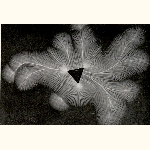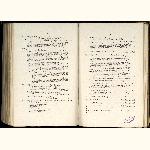Details of exhibit
- Exhibition:
- 1915 Sixtieth Annual Exhibition of the Royal Photographic Society of Great Britain
- Exhibit title:
- Electrical Spark Discharges
- Exhibitor:
- H. H. Hoffert
- Section:
- III. Scientific and Technical Photographs, &c.
- Group Title:
- 199 to 202 Electrical Spark Discharges
- Exhibit No.:
-
- Description:
- The method by which these photographs were taken in to pass a single instantaneous discharge of an electrical machine directly over the surface of the photographic plate either from a needle point or from a small triangular piece of thin sheet metal laid on the plate. In some cases both positive (+) and negative (-) discharges are taken simultaneously on the same plate by bringing both terminals of the electrical machine into play, in other cases only discharge + or - is shown, the opposite terminal of the machine being in that case below the plate.
Differences in the forms of the spark discharges are due toľ
(1) Whether the discharge is + or -. Nos. 4, 6, 12, 14, 19 are good examples of the + sparks; Nos. 3, 4, and 13, of the - sparks.
(2) The intensity of the spark. No. 1 shows very weak discharges both + and -, Nos. 7 and 8 show weak discharges, - and + separately, Nos. 17 and 22 are moderately strong discharges from metal triangles; in No. 23 the discharge nearly passes across from one triangle to the other.
(3) Whether the photographic plate is dry or wet. Modifications in the form of the spark discharge by wetting the photographic plate are shown by comparing Nos. 2 and 1;p 9 and 10 with 7 and 8; 15 and 16 with 13 and 14; 18 with 17. The general effect is a suppression of detail, the wet plate having become more conducting to the electrical discharge. This is shown clearly in Nos. 25 and 16 where the discharges, - and +, were passed into the centre of wetted circles on the plate. The way in which the discharges pass freely through the wet spots to reappear round their circumferences is clearly shown. - Exhibit type:
- Photographic equipment and supplies
- Process:
- [Not Listed] ()
- Award:
- none


